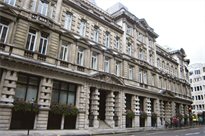 The London Wall is a defensive wall built by the Romans in the 2nd or 3rd century from Kentish stone; it formed the foundations for the later City Wall which historically defined the boundaries of the city. The wall protected the city from invasion and contained the Great Fire of London. It underwent some demolition during the 18th and 19th century and many parts were destroyed in the bombings during the Second World War. Today, part of the route of the wall is followed by the road named London Wall, from Aldersgate and east to Bishopsgate.
The London Wall is a defensive wall built by the Romans in the 2nd or 3rd century from Kentish stone; it formed the foundations for the later City Wall which historically defined the boundaries of the city. The wall protected the city from invasion and contained the Great Fire of London. It underwent some demolition during the 18th and 19th century and many parts were destroyed in the bombings during the Second World War. Today, part of the route of the wall is followed by the road named London Wall, from Aldersgate and east to Bishopsgate.
The remaining sections of the wall have been protected in gardens and museums or incorporated into the construction of modern buildings. The largest and best preserved section of the London Wall stands at Tower Hill, just north of the Tower of London at nearly 11m tall. During the 17th Century, other buildings were put up either side and parts were destroyed during construction. In the 1930s, the buildings which obscured this section of the wall were cleared away and it is currently preserved by English Heritage. It can be easily reached by train as it is situated opposite Tower Hill Station.
At Tower Hill Station itself there is a section of The London Wall preserved in a green space beneath the underpass, encircled by walkways for commuters to view. When the station was built, the site was excavated and on discovering the fragmented remains of the wall, construction was redesigned around it. From Tower Hill station, north along Coopers Row sits the Grange City Hotel one of whose courtyard walls incorporates a section of the Roman wall with medieval additions.
The Barbican estate is the area in east central London that sits along London Wall road, developed in the 1950s after bombings in World War II. The area now encompasses apartment blocks, a theatre – The Barbican Arts Centre, The Museum of London and The Guildhall performing arts school. The design of the estate incorporates sections of the London Wall. The architects, Geoffrey Powell, Peter Chamberlin and Christophe Bon were some of the most important in the post-war modernist movement. They commemorated the wall in the buildings named Wallside and Postern and sections of the wall can be seen near Wallside and in the gardens along London Wall. A bastion is preserved in the gardens between Wallside and Mountjoy House. To visit the Barbican Estate, alight at Barbican tube station, the estate is directly across the A1, on Aldersgate Street.
The Church of All Hallows on the Wall was built by George Dance the Younger in 1767 to mark the site of an earlier church built on a bastion of the original Roman wall. It is so named because its sits on the London Wall road and the wall that runs alongside the church has been built to include remaining sections of the city wall. It can be reached by taking Old Broad Street, just south of Liverpool Street Station.
Today a large number of London Wall buildings house exclusive office space including One London Wall, Aldersgate Street Building, which provides 18,500 square metres of office accommodation. Another example is 125 London Wall, also referred to as Alban Gate, which is comprised of two towers, and the headquarters of JPMorgan Chase.
The newly designed London Wall Place, a two acre commercial campus, enjoys an elevated high walk way, created by Make Architects, and references the history of London’s architecture, while providing two new office buildings which can accommodate up to 5000 employees. ‘The beauty of this project lies in recognising it is simply the latest layer in the history of this site, the next trace to be remembered. We’ve designed state-of-the-art offices, but it’s the combination with the public realm that has attracted the occupiers, not just the commercial spaces themselves. It is about bringing in a social, human, tactile scale to the City, and the architecture is all the more successful for the spaces around it,’ said Sam Potter, lead architect at Make.
A selection of other London Wall Buildings are currently being converted to provide additional office accommodation along with commercial and retail space to keep up with ever growing demands of businesses in the City of London.
Find out more about serviced office space and executive suites in the London Wall Buildings and available workspace in the surrounding areas of Barbican, Liverpool Street and Moorgate.
Further information on important London landmarks, areas and buildings including the Shard Building, the Docklands area and popular tours of London.

It’s really interesting to know about the London Wall Buildings. London is such a historic place and there are many more famous London Landmarks that adds to the London pride.